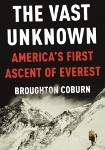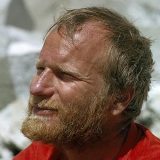Review of Broughton Coburn's (Nepal 1973-75)The Vast Unknown
 The Vast Unknown:
The Vast Unknown:
America’s First Ascent of Everest
by Broughton Coburn (Nepal 1973-75)
Crown Publishers (a division of Random House). $26.00
300 pages
2013
Reviewed by Don Messerschmidt (Nepal 1963-65)
This is a book of true high adventure. Good reading for those of us who like outdoor adventures and severe challenges. This book is full of them, start to finish.
Just a little past half way along, the story of the 1963 American Mount Everest Expedition reaches a dramatic climax, of sorts. On May 22, 1963, standing ready to challenge the peak from a point high on the ridge, the two American climbers, Hornbein and Unsoeld, faced a strategic decision. “Favorable luck, strange omens, obstacles, and argument be damned,” they thought. “The dazzling, vast unknown¾a key threshold to the uncertainty… was beckoning them forward and upward.” This “was no longer an academic exercise,” writes Brot Coburn, this was a decision point, whether to continue up the unknown route to the summit of Sagarmatha / Chomolungma / Mount Everest.
“Willi… stopped, coiled the rope, and I wondered why he was standing there…”, Tom Hornbein later wrote in his diary. “I came climbing up and joined him and looked ahead. I kept telling myself: It can’t be the summit; it’s two near.” Then, together, they walked the last 40 feet to the top. It was 6:15 p.m., far later than they had hoped and expected to arrive at the top; far later than was safe for them to arrive there. Tom Hornbein and Willi Unsoeld were making history¾the first ascent of Everest by the West Ridge.
“We felt the lonely beauty of the evening, the immense roaring silence of the wind, the tenuousness of our tie to all below,” Hornbein goes on. “There was a hint of fear: not for our lives, but of a vast unknown which pressed in upon us. A fleeting feeling of disappointment¾that after all those dreams and questions, this was only a mountain top¾gave way to the suspicion that maybe there was something more, something beyond the three-dimensional form of the moment. If only it could be perceived.’…”
The Vast Unknown by Broughton Coburn (Nepal 1973-75) chronicles that year’s whole show on Everest, including the May 1st ascent via the South Col by Jim Whittaker and Nawang Gombu and, three weeks later, Lute Jerstad and Barry Bishop’s repeat ascents by the same (and now most popular) route and the simultaneous West Ridge ascent by Hornbein and Unsoeld. These five Americans and one Sherpa were, respectively, the 7th to the 12th human beings to stand atop the highest point on earth.
Theirs is a classic story in the history of mountaineering. Coburn puts it all into a new perspective, revealing personal ambition and collective spirit as well as triumph and tragedy on the peak. His retrospective a half century on is a classic in itself.
Both teams of climbers had arrived late at the top, suffering from exhaustion, dehydration, oxygen canister problems, frostbite and, ultimately, the dark of night and dangerous footing on steep snow and ice high above everyone else on earth. They were supposed to have met up at the summit, but Hornbein and Unsoeld were late; so Jerstad and Bishop started back down towards the South Col. Had the two teams not found each other during their descent, some or perhaps all of them would surely have perished.
Finally, unable to proceed safely downward, “the four men swallowed an impossible truth: There was no choice but to stop and wait for the morning.”
The story of their forced bivouac 28,000 feet is, in a word, chilling!
“No preparation was needed: they simply sat down… and curled up on their pack frames. They were dehydrated, oxygen-starved, and exhausted.” By then it was past midnight, about a thousand feet below the summit and more than five miles above sea level, well within the ‘Death Zone’ where the human body begins to die, unable to acclimate to the harsh conditions of oxygen debt and bitter cold. “If they survived the night,” Coburn says, “it would be the highest successful bivouac in human history.” They did, and it was.
Coburn’s rewrite of the 1963 Americans on Everest history is riveting in its intensity, and dazzling in its presentation. It is a superb piece of writing, about an event in American mountaineering that may never be bested. But, more than a spectacular climbing story, it is equally revealing of the human aspects of severe challenges. Unlike most mountain expeditions, the American team included a psychologist, sociologist, and glaciologist, each a fine climber and well known scientist. Their presence and research added all the more depth to the story.
A year later while this reviewer was trekking in the Nepal hills with Tashi Sherpa, one of those who carried supplies in preparation for Hornbein’s and Unsoeld’s assault on the West Ridge, he heard more of the story. One night on the West Ridge route, Tashi recalled, a ferocious wind came up, ripping the tents loose and almost dumping the whole crew thousands of feet down the north slope toward Tibet’s Rongbuk Glacier.
Tashi summed it all up like this: “Big wind coming, sahib. Tents down going!”
And later, I interviewed Fr Marshall Moran, SJ, the Jesuit educator and Ham radio operator who was in constant communication with Everest Base Camp that year. In the radio shack with him on the night of May 22nd were two of the climbers wives, Jolene Unsoeld and Lila Bishop. Fr Moran was quite frank with them. They all knew that the South Col team had not left the summit until after 4 o’clock p.m. After that, there was no more news from the top, only silence. And fear. What was the fate of the West Ridge team? They wondered. Moran told the two women that it was unlikely that either team could make it down to the safety on the South Col before dark. It seemed to him that the climbers would have to spend a frigid, windy night out on the mountain.
That’s when Fr Moran invoked the supernatural. “We sat in the shack for an hour after the disturbing no-news from Base Camp,” he told me. “Everyone was anxious and very nervous. We had all heard about the typical high velocity night winds on the summit and that they were the climbers’ greatest threat. I said we’d all better go home and pray that there would be no wind this night, knowing that windless nights on the peak in that season were very rare. At our benediction service with the Jesuit Fathers at the school late that evening, I prayed for the safety of the climbers. I prayed that the winds would cease, if only for this one night.”
Back in the radio shack the following morning they heard good news from Everest Base Camp¾that Fr Moran’s prayers must have worked, for the winds across the summit had been stilled, the first time in weeks. Also that the West Ridge climbers had arrived on the summit two hours after the others had come and gone, that all four climbers had eventually met up on the way down, that they had, indeed, spent the night out in the cold, but also that all were alive and as well as could be expected, though not without some frozen fingers and toes…
Months later over supper in Kathmandu one evening, Willi Unsoeld told his version of that harrowing night out on the mountain to several guests including Fr Moran, this reviewer, and a noted American reporter who lived in Nepal. With a bit of wonder and awe, Unsoeld reminded us that without Fr Moran’s intercession they might all have perished in the wind. Earlier on the day he and Hornbein summated, Unsoeld recalled, the wind gusts across had reached an estimated 70 miles per hour. But, inexplicably, he said, the summit’s typical high velocity winds stopped for the night.
After a moment of silence Marshall asked us, quietly: Was it really so unexpected, so strange? After all, he subtly reminded us, hadn’t he prayed for just that?
To which the reporter, a true skeptic, muttered, “Now, really, you don’t believe that!?”
Those were eventful, challenging and frightening times, as only Himalayan climbing, and writing about it, can be.
* * *
When William F. (Willi) Unsoeld climbed Everest in 1963 he was on leave from his position as the second Peace Corps Country Director  for Nepal. He had been hand-picked for the assignment by Sargent Shriver, at the urging of the first Nepal PC Country Director, another icon of American mountaineering, Robert H. (Bob) Bates. The reviewer, an anthropologist and writer, served under Unsoeld in Nepal, 1963-65. He’s the author of several books on Nepal, including Fr Moran of Kathmandu: Priest, Educator and Ham Radio ‘Voice of the Himalayas’ (2nd ed., 2012).
for Nepal. He had been hand-picked for the assignment by Sargent Shriver, at the urging of the first Nepal PC Country Director, another icon of American mountaineering, Robert H. (Bob) Bates. The reviewer, an anthropologist and writer, served under Unsoeld in Nepal, 1963-65. He’s the author of several books on Nepal, including Fr Moran of Kathmandu: Priest, Educator and Ham Radio ‘Voice of the Himalayas’ (2nd ed., 2012).
Broughton Coburn was a Nepal PCV, a decade later (1973-75). Coburn’s books on Everest include Everest: Mountain Without Mercy (1997), Touching My Father’s Soul: A Sherpa’s Journey to the Top of Everest, with Jamling Tenzing Norgay (2001), and Triumph on Everest: A Photobiography of Sir Edmund Hillary (2003). Coburn is also a coauthor with David Breashears and Tim Cahill of Everest (2003), and with Conrad Anker, Bernadette Mcdonald and David Breashears of The Call of Everest: The History, Science and Future of the World’s Tallest Peak (2013).
Two other books are more closely associated with Brot Coburn’s Peace Corps experiences in village Nepal: Nepali Aama: A Portrait of a Nepalese Hill Woman (1982) and Aama in America: A Pilgrimage of the Heart (1995).
No comments yet.
Add your comment